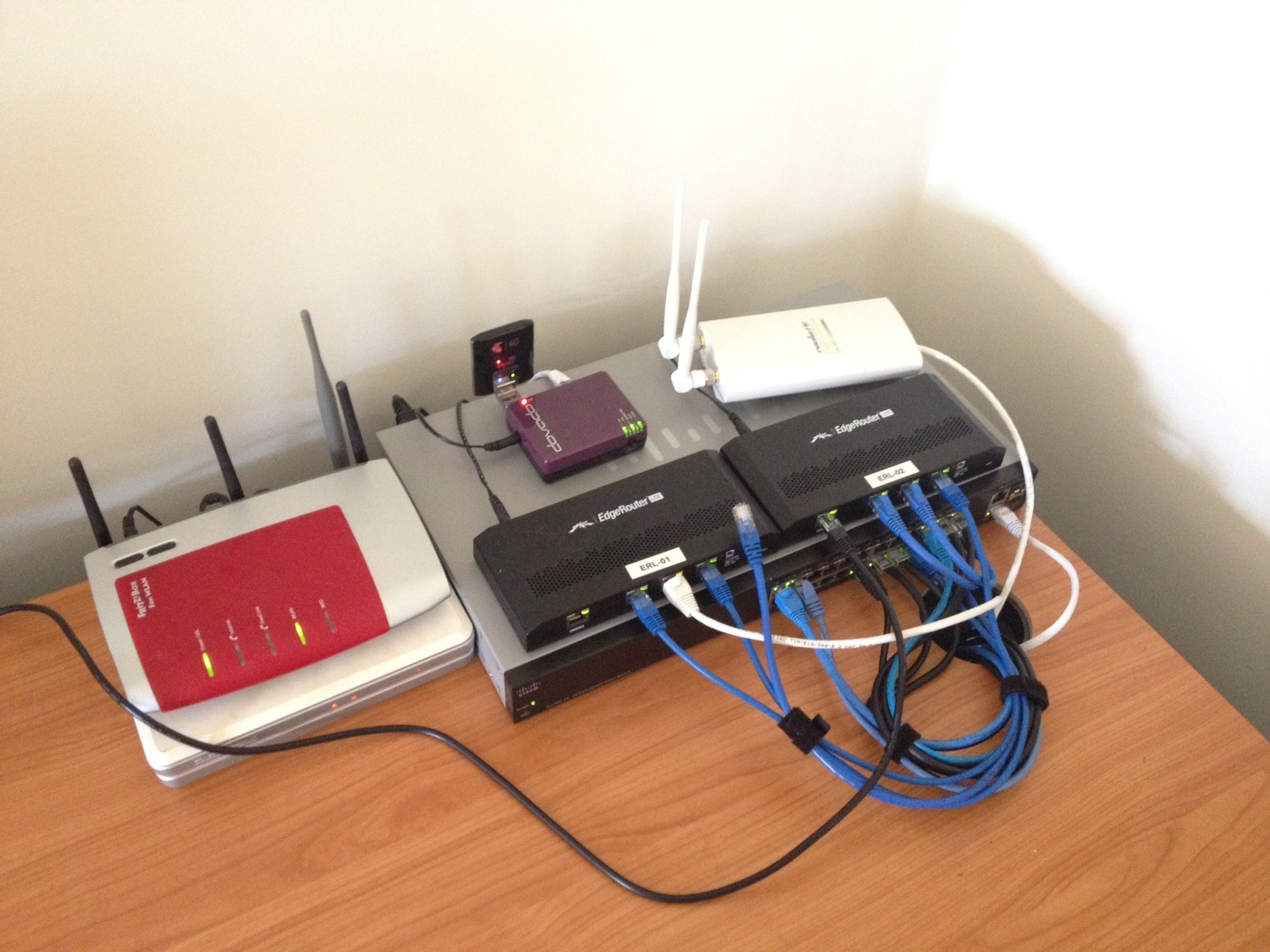I have recently stumbled across DN42 and have been fairly excited to transition my networking know how from layer 3 meshing via OLSR (back in the NTFreenet days) to now understanding more of complex enterprise networks.
What better way to learn about such things than to:
- Install a complex enterprise network in your own home
- Make sure you have outage sensitive customers on the network. Any Wife, kids or friends will usually do
And so with this in place I introduce my humble home lab.

Details
The network is so far comprised of:
- 2x Ubiquiti ERL
- 2x Ubiquiti Rocket M2
- 1x Cisco SG200-26
- 1x Linksys SLM2008
- 1x Fritzbox 7270 + Fritzfon DECT handset
- 1x Asus WL500GPV2
- 1x Netcomm NB6PLUS4
- 1x Dovado GO + Seirra Wireless 320U
There are also some servers
- 1x SmartOS host - 2x gbit nics plus 1x IPMI
- 1x QNAP TS-410 - 2x gbit nics
And finally some 11 clients between wired clients, mobile clients and media devices.
Layer 1 and 2
Things a pretty boring here. You can see most of the detail already in the picture at the start of this post. None the less here is the documentation for my benifit.
I have not really found a cleaner way for this short of tables so you will have to suffer through or suggest a better alternative!
Bedroom
NB6PLUS4
| Interface | Endpoint |
|---|---|
| ADSL | Filter |
| Port 1 | RocketM2-eth0 |
Office
ERL-01
| Interface | Endpoint | VLANS |
|---|---|---|
| eth0 | SG200-26-ge21 | lag1 |
| eth1 | SG200-26-ge22 | lag1 |
| eth2 | ERL-02-eth2 | NA |
ERL-02
| Interface | Endpoint | VLANS |
|---|---|---|
| eth0 | SG200-26-ge23 | lag1 |
| eth1 | SG200-26-ge24 | lag1 |
| eth2 | ERL-01-eth2 | NA |
SG200-26
| Interface | Endpoint | VLANS |
|---|---|---|
| ge1 | Desktop-eth0 | 110UP |
| ge2 | Desktop-eth0 | 110UP |
| ge3 | NA | 110UP |
| ge4 | NA | 1UP |
| ge5 | NA | 1UP |
| ge6 | NA | 1UP |
| ge7 | NA | 1UP |
| ge8 | NA | 1UP |
| ge9 | NA | 1UP |
| ge10 | SLM2008-ge1 | 1UP,130T,140T |
| ge11 | Fritz-lan1 | 140UP |
| ge12 | WL500GPv2-eth0 | 150UP |
| ge13 | NA | 1UP |
| ge14 | NA | 1UP |
| ge15 | NA | 1UP |
| ge16 | NA | 1UP |
| ge17 | NA | 1UP |
| ge18 | Server-ipmi0 | 130UP |
| ge19 | Server-eth0 | 120UP |
| ge20 | Server-eth1 | 130UP |
| ge21 | ERL-01-eth0 | lag1 |
| ge22 | ERL-01-eth1 | lag1 |
| ge23 | ERL-02-eth0 | lag2 |
| ge24 | ERL-02-eth1 | lag2 |
| ge25 | RocketM2-eth0 | 191UP |
| ge26 | Dovado-lan0 | 192UP |
| lag1 | ERL-01-bond0 | 1UP,120T,150T,161T,191T,192T |
| lag2 | ERL-02-bond0 | 1UP,110T,130T,140T,162T,191T,192T |
Lounge
SLM2008
| Interface | Endpoint | VLANS |
|---|---|---|
| ge1 | SG200-26-ge10 | 1UP,130T,140T |
| ge2 | Wired Client | 140UP |
| ge3 | Wired Client | 140UP |
| ge4 | Wired Client | 140UP |
| ge5 | Wired Client | 140UP |
| ge6 | NA | 140UP |
| ge7 | TS410-eth0 | lag1 |
| ge8 | TS410-eth1 | lag1 |
| lag1 | TS410-bond0 | 140UP |
In the next installment we will describe the layer 3 networks!

